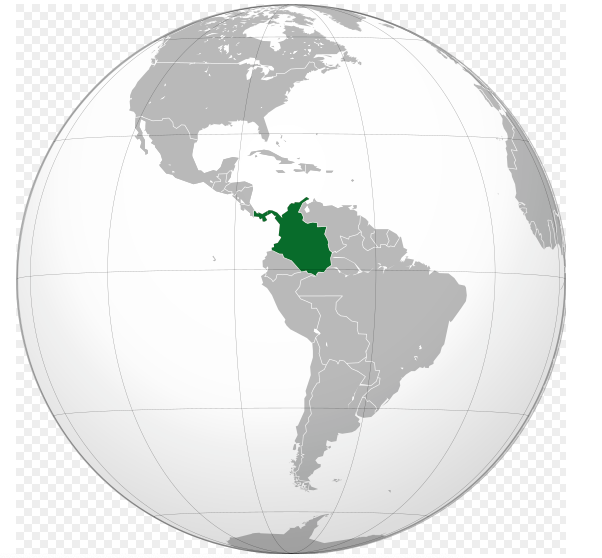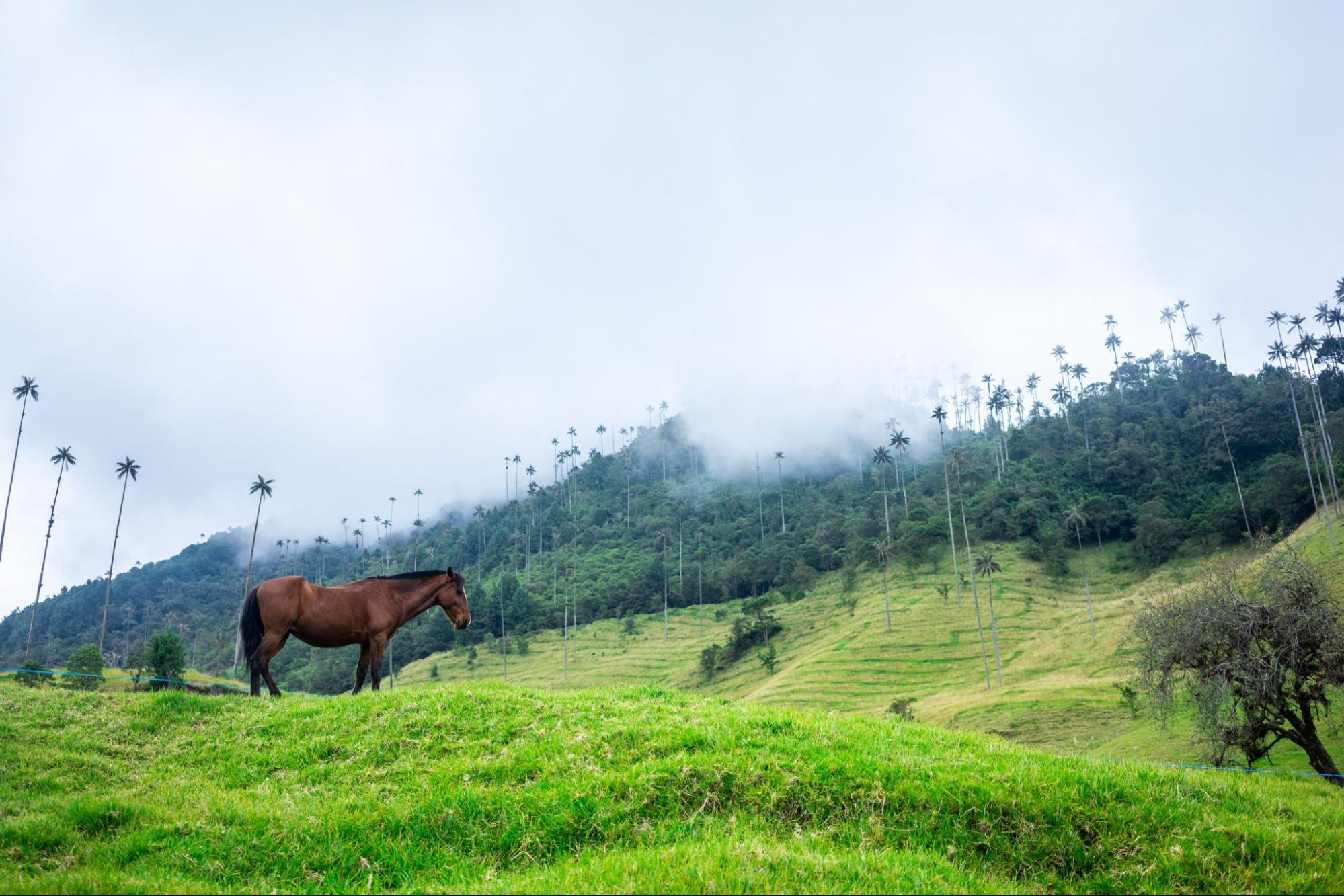3.9 Conflict in Colombia: A Case Study of inequality and Globalization


Figure 3.30. Colombia on the globe
Figure 3.31. Mountainside in Cocora, Salento, Quindío, Colombia, by Julian-Florez
The beginning of this chapter introduced the story of former Revolutionary Armed Forces of Colombia (FARC) soldiers turned tour guides after the peace accords. Considering what we’ve covered in this chapter, what inquiries do you have about the lives of these FARC soldiers turned tour guides and the society where they were born?
- What can you imagine might have transpired to push these former FARC combatants to spend years fighting against the state of Colombia?
- What has changed to now enable them to find such a different place in society?
The 7:27 minute video (Figure 3.32), A Deadly Peace in Colombia as FARC Disarms is a good place to start. It provides some clues for our understanding, from FARC members themselves who are transitioning to civilian life. As you listen, what connections can you make between their life experiences and what you’ve learned about global inequality in this chapter? Also, pay attention to the experiences in their lives that are shaped by globalization.
Figure 3.32 A Deadly Peace in Colombia as FARC Disarms
While global inequality and the impact of globalization can be seen everywhere, the social changes seen over the past sixty years in the Republic of Colombia, including the emergence and persistence of its internal conflict, is a good scenario to study. How and why does inequality exist in Colombia? How has inequality and economic globalization influenced the Colombian conflict?
3.9.1 Colombia, Globalization, and Inequality
Resting at the gateway north to Central America (Figure 3.30), Colombia boasts the second-highest biodiversity in the world (Figure 3.31), with thirty-five percent of its territory in the Amazon region. Most of this territory is yet to be explored by non-indigenous people as this area is hard to reach and the environment is untamed. It’s a richly diverse population, with 115 indigenous groups (Autoridad Nacional de Gobierno Indígena n.d.) and the second largest African descendant population in Latin America (Minority Rights Group 2008).
3.9.1.1 Colombia’s Conflict: A Brief History
Colombia’s fifty-year civil war was in part rooted in a conflict known as La Violencia, which was spurned by the 1948 assassination of a left-wing political leader, Eliécer Gaitán. Later, conflicts between anti-communist initiatives and left-wing political actors reached a crescendo when in 1964 the leaders of the Colombian Communist Party (PCC) formed FARC as an armed insurgent group. The FARC and other insurgent groups were fighting for the rights of the poor, including protection from government and paramilitary violence against the civilian population.
When Gaitán was killed, he was combating political, social, and economic inequality, and promoting land reforms, or a system that would diminish the concentration of land-ownership among the elite. His platform hoped to bring a direly needed economic democracy to Colombia and promoted increased political participation among farmers, peasants, and middle and lower-class citizens (Sharpless 1979).
PCC members organized groups of individuals who felt neglected by the Colombian government, guiding them to settle throughout the countryside and create their own communities. In 1964, the FARC continued that ideology operating as a peasant force and promoting agricultural work and resistance to foreign takeover of resources. They promoted social justice through education and health care, and simultaneously became authorities in rural areas, often with considerable force and threat of violence. Eventually the FARC took control of 40% of Colombia’s territory.
In response, the government of Colombia expressed interest in restoring order and stability and protecting the rights and interests of its citizens in the face of insurgent control. Far-right paramilitary groups, originally organized to defend wealthy landowners, reacted to perceived threats by guerrilla movements and often worked in conjunction with Colombia’s military. Wealthy crime syndicates were involved with each group, and fought to maintain their international drug trafficking industry.
More than 220,000 died in the war, most of them civilians, and the conflict generated the world’s second-largest population of internally displaced persons, people who are forced to leave their home but who remain within their country’s borders.
3.9.1.2 Conflict after the Peace Agreement
In 2016 the Colombian government and the FARC signed a peace agreement that marked an official end to the oldest ongoing armed conflict in the Americas. As the peace process moves forward and soldiers return to civilian life, many sigh in relief to a promise of an end to the long-era of violence in their homeland. Opportunities are expanding for civilians who previously struggled to survive during the war. Many former armed actors are finding alternate ways of supporting their families, including former FARC soldiers who have begun building upon tourism opportunities as you read about at the beginning of this chapter.
However, despite the peace accords and efforts at reconciliation much of the longstanding conflict in Colombia still continues. More than 500 human rights defenders have been killed in Colombia since 2016, most documented in areas where drug production and trafficking are common. Killings still continue at the hands of the FARC as well as paramilitary groups that were sponsored by the Colombian government during the war (Human Rights Watch 2022). Some communities report that they experienced less violence or coercion before the peace agreement was signed (Tackling Colombia’s next generation in arms 2022).
3.9.1.3 Inequality within Colombia
Why does peace remain so elusive in Colombia? There are obvious connections between inequality and conflict between groups around the world (Bahgat et al. 2017). In Colombia’s case the severe social and economic inequality that existed in the country was an unmistakable condition that led to the civil war. It can be certainly said that these inequalities are what perpetuate violence in Colombia today, despite the massive efforts toward peace. Let’s look at how Colombia’s internal inequality persists.
Colombia is one of the top ten most unequal countries in the world in terms of family income. The United Nations reports that in 2018 Colombia’s 90/10 income inequality ratio is 60.4 and the World Bank reports Colombia’s Gini Coefficient as 50.4. [GDP, GNP, GNI]. Particularly disruptive is inequality related to land-access and ownership. According to the NGO Oxfam, 80% of land in Colombia is in the hands of just 14% of owners and that this concentration has actually increased over the last 50+ years (Gillin 2015).
This concentration of land ownership is among the highest in the world, and it is this land-inequality that shapes rural poverty. During the war, land inequality was amplified as violence and forced displacement caused rural Colombians to lose up to 8 million hectares (Oxfam 2013).
In addition to fighting for rights of the poor, the FARC also stated they were fighting against the monopolization of Colombia’s natural resources by multinational corporations, and against the political influence of the U.S. in the internal affairs of Colombia (i.e. Plan Colombia). Much of the land theft that has occurred in Colombia is connected to landowners and multinationals seeking to acquire and/or expand their landholdings. The FARC, in response to this land inequality and expulsion of poor farmworkers, has also been involved in land theft (Oxfam 2015).
Political scientist Charles D. Brockett exclaims that the “The most explosive situations arise when peasants believe that have been ‘unjustly’ dispossessed of land.” (Brocket 1992 cited in Gillin 2015: n.p.). When we examine Colombia through the lens of land inequality; particularly considering the violence that has been part of that land dispossession, the persistence of her conflict becomes more clear.
3.9.1.4 Land, Tour Guides and Deforestation
Since the peace process began, and the FARC began to demobilize, deforestation has worsened dramatically in Colombia. During the war, FARC rebels maintained a significant level of control over how land was used and they ensured that thick tree canopies existed above their encampments to prevent the state from identifying them. With the demobilizations, that control waned, leaving a vacuum for deforestation. Simultaneously, tens of thousands of internally displaced people have found themselves with little option but to create new livelihoods by clearing forest. Some are coerced or co-opted into working for remaining or newly formed armed groups (International Crisis Group 2021).
A primary initiative of the Peace Agreement between the Colombian Government and the FARC is called Integral Rural Reform (IRR). It established that within ten years a fund of 3 million hectares would be dedicated to allowing peasants with no land or insufficient land to gain access to land. IRR was created to increase the well-being of peasants, and promote integration and social development by sparking opportunities for the Colombian countryside, especially for the populations most affected by the armed conflict and poverty.
This initiative is a testament to the importance of equal land distribution. Other initiatives are in place to support the many armed actors of Colombia’s war, as well as the many people who are still displaced. The tour businesses introduced in the beginning of this chapter is one example. Many Colombians and concerned climate scientists around the globe are hopeful that such initiatives will help curb environmental and social issues in the region.
3.9.2 Licenses and Attributions for Conflict in Colombia: A Case Study of inequality and Globalization
“Conflict in Colombia” by Aimee Samara Krouskop is licensed under CC BY 4.0.
Figure 3.30: Colombia on the globe. Published by Wikipedia and found here.
Figure 3.31: The mountainside in Cocora, Salento, Quindío, Colombia is created by Julian-Florez, via Unsplash
Figure 3.32 Video, A Deadly Peace in Colombia as FARC Disarms Video, is published on YouTube by The New York Times
